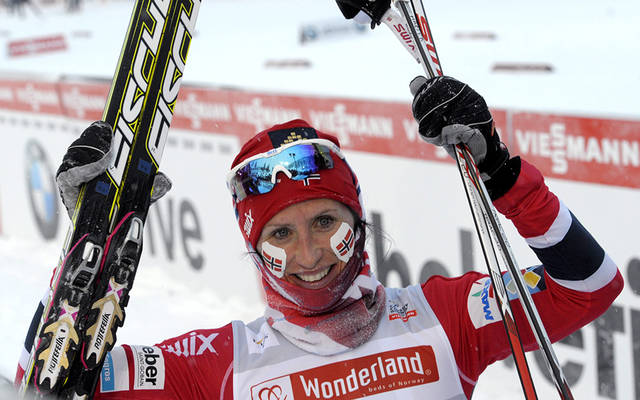Do you have what it takes to be an Olympian?

ASSOCIATED PRESS
Norway’s Marit Bjorgen celebrates after winning the women’s cross country 10km freestyle skiing competition at FIS World Cup Ruka Nordic Opening in Finland in 2013. A new study published in Frontiers of Physiology analyzed 17 years’ worth of records about Bjorgen’s workout routines.
Becoming the most decorated Winter Olympics athlete in history requires snow, fortitude, technique, squats, more squats, a team of dedicated physiologists, a stable body weight, running shoes, high-intensity intervals, about 940 annual hours of exercise — much of it conducted at a surprisingly light intensity — and a willingness to substantially shake up training when it is no longer working well.
Those are the findings of a new study published in Frontiers of Physiology that analyzed 17 years’ worth of records about the workout routines of the Norwegian cross-country ski racer Marit Bjorgen, who will turn 38 in March.
Bjorgen won five medals at the Pyeongchang Games, making her the most winning athlete there, for a career total of 15 medals, eight of them gold.
She also appears to have led a thoroughly examined life, keeping scrupulous, detailed diary entries about each of her workouts from the time she became a senior-level athlete at age 20.
Recently, she shared the entirety of these entries with scientists at Nord University in Bodo, Norway, and the Norwegian University of Science and Technology in Trondheim, who already had been working with her on regular fitness testing and monitoring.
In the past, these scientists had analyzed similar records from some of the top male cross-country athletes in Norway. But much less was known about the routines and responses of accomplished female endurance athletes.
Don't miss out on what's happening!
Stay in touch with breaking news, as it happens, conveniently in your email inbox. It's FREE!
So for the new study, which was published before the start of the Olympics, the scientists dove into the entries from Bjorgen. They also gathered and compared data about her competitive results over the course of 17 years.
They were looking for patterns and lessons that might be of use for other cross-country ski racers and also, potentially, anyone interested in high-level endurance competition.
What they found confirmed much of the currently accepted wisdom about how best to structure seasonslong workout routines for endurance athletes.
But in some respects, Bjorgen’s training also confounded expectations about how young athletes progress and what humans, including women, are capable of.
The data for the study began in 2000, when Bjorgen was 20 and a newcomer to senior-level racing. She already had accumulated medals and championships at the junior level, mostly in short, sprint-distance events. Now, Bjorgen wished to start winning longer-distance races as well.
But her training at the time tended to skew short, at least by the standards of cross-country skiing. According to her training diary, she was exercising for about 520 hours a year, with much of this time spent in strenuous but brief sessions, most of them shorter than an hour.
Her competitive performance, meanwhile, began to plateau, with her best times stubbornly refusing to drop.
So in her mid-20s and with the encouragement of and advice from the university scientists, she upended her routine.
Most significantly, she added volume, lots of it. Her workouts gradually became much longer, eventually lasting for two or three hours, says Guro Strom Solli, a doctoral student at Nord University, who once trained and raced with Bjorgen and led the new study.
By the time Bjorgen reached her early 30s and embarked on her five most successful years as a racer, from 2010 through 2015, she was training for around 940 hours per year, about 80% more than a few years earlier.
Most of these added workouts were performed at what, in cross-country racing terms, counts as “light” intensity, Solli says, with Bjorgen’s heart rate hovering at about 80% of her maximum. By contrast, her heart rate had tended to exceed 90% of her maximum during most of her shorter workouts when she was younger.
Bjorgen continued to complete several brief, strenuous interval sessions each week. But a far greater percentage of her workouts now were prolonged and, by her standards, gentle. Most of these workouts were on skis, but during the snowless summers, she ran.
She also began focused, frequent weight training, concentrating in particular on her core and upper body. Her biceps eventually became so honed that blogs today celebrate them.
And she began to win everything, scooping up world championships and Olympic medals at sprint and long-distance events.
The lessons for more average athletes from her training arc are perhaps subtle, Solli says, since Bjorgen most likely has physical, genetic and psychological gifts that have thoughtlessly bypassed the rest of us.
But one takeaway is that athletes should consider shaking up their training to some extent if they begin to feel stagnant, says Oyvind Sandbakk, a professor and manager of the Centre for Elite Sports Research at the Norwegian University of Science and Technology, who oversaw the study.
Bjorgen improved when “she changed her regime a bit,” he says, shifting the bulk of her workouts from short, hard sessions to longer ones.
That progression also hints that young athletes in endurance sports might do well to slowly add volume to their workouts, over the course of many years, Solli says.
But, of course, a case study directly concerns only the individual studied and is not an experiment, so it cannot tell us whether Bjorgen might have thrived equally using different training techniques.
But the research does reiterate what watching the Olympics have already made clear. Bjorgen, as an athlete, is remarkable and probably, Solli says, “unique.”
© 2018 The New York Times Company



